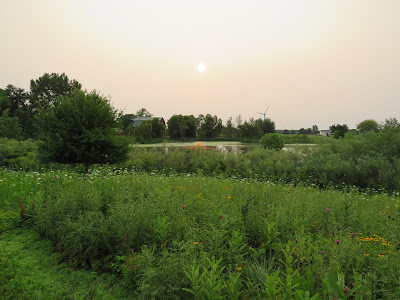Once again, I’m hiking in the 90-acre Forest Hill Nature Area- property I was fortunate to spend 23 years of my professional life helping to convert from farmland into a thriving outdoor learning center. With morning temperatures in the low 60’s and the sun penetrating a hazy sky, I make my way on a mowed path toward the top of Reflection Hill while enjoying the sight and sound of an Eastern Kingbird. It’s not called a kingbird for nothing. It has a crown of red feathers on its head that is usually concealed (stock photo). When it encounters a potential predator, the kingbird may simultaneously raise its bright crown patch and dive-bomb the intruder. Exploring the hilltop, I spot a Cottontail Rabbit as well as a covering of native wildflowers, due to a major restoration effort, evident throughout the Nature Area. Blossoming Milkweed attract insects, including: a Japanese Beetle, a Milkweed Beetle and a Milkweed Bug. Bull Thistle attracts a Cabbage White Butterfly while Queen Anne’s Lace attracts a Cucumber Beetle. Other wildflowers I observe include: a mix of Black-eyed Susan and Coreopsis, Marsh Betony as well as a lovely pink variety of Queen Anne’s Lace. Moving down the hill along the edge of Willow Wallow, I listen to the sound of Green Frogs while looking at a Green Heron perching in a tall, dead tree. Moving through South Woods, I come upon some fungi including: tiny Scarlet Waxcap mushrooms and a large Puffball. At the entrance to Northwoods, I spot Chinquapin Oak leaves peppered with red spots. Called oak galls, they’re created by tiny parasitic wasps that lay their eggs on the leaf. Subsequently, the larvae secrete chemicals that cause the galls to form. Moving past the vernal pond, I exit the woods and arrive at Mallard Marsh in time to see a resting Monarch-look-a-like butterfly, called a Viceroy as well as a swimming Juvenile Wood Duck. Coming around to the classroom building, I stop by Grebe Pond where several Canada Geese have deposited scat on the dock. Moving around the pond, I find myself walking through remnants of a native prairie that was established several years ago. Blossoms that remain include Purple Coneflower and Spiderwort. Further ahead, I come upon a pile of feathers-remains from a recent predator-prey event. Closer examination reveals a likely encounter between a fledgling Ring-necked Pheasant and a hawk or owl.
Summer steals most of the glory.
Flora and fauna in colorful arrays.
But what about autumn’s aura?
When the woods turns maple red
and the meadow turns goldenrod.
Don’t forget winter’s wonderland?
When crimson cardinals perch in
evergreens, draped in snowy white.
And then there’s splendid spring?
When pink trillium blossoms
decorate a drab litter of leaves.
Every season, winter to fall,
Nature’s handiwork, glory to all!
D. DeGraaf



